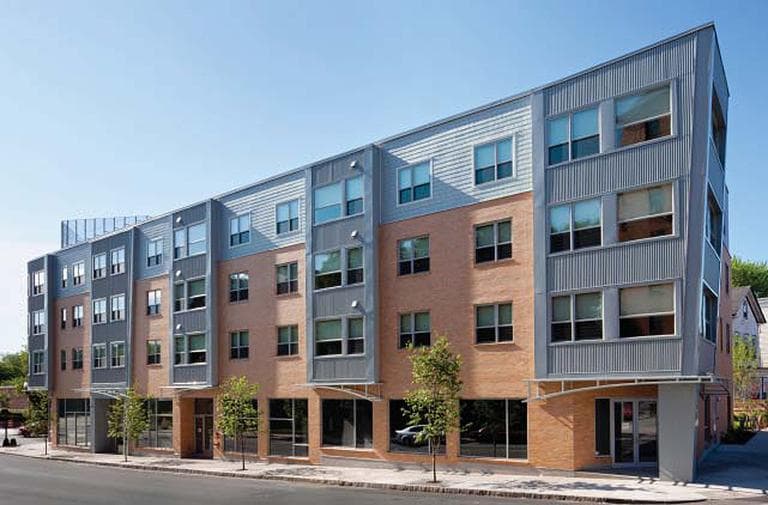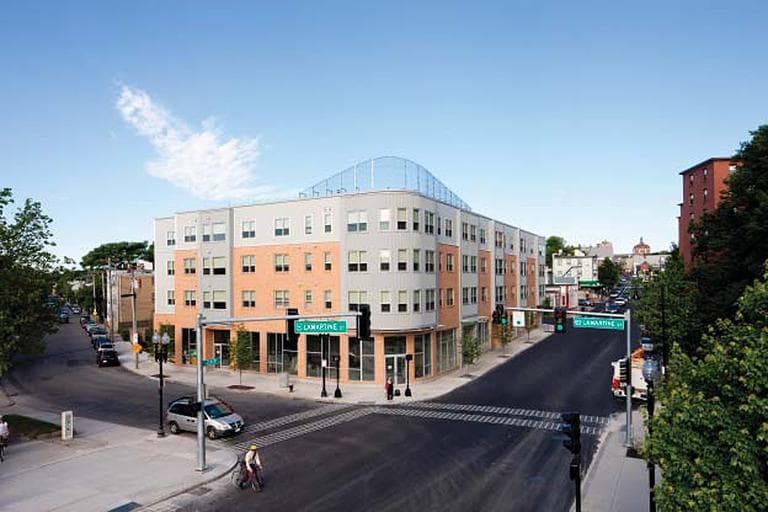Advertisement
New HUD Cuts Pose Challenge To Innovative Public Housing Projects
Resume
There will soon be a lot less money available for public housing in Massachusetts. The 2012 federal budget includes a 9 percent, or $3.8 billion, cut to the Department of Housing and Urban Development.
And new funding formulas released by HUD indicate double-digit cuts to key housing programs in the Bay State. That's bad news for housing agencies that are struggling with maintenance backlogs while at the same time fielding an influx of new applicants.
An example of what's at stake is an innovative new affordable development in Jamaica Plain — the kind of project that may now be a lot harder to replicate.
Old-School Public Housing Insular
Step out of the Jackson Square T stop and start walking toward Hyde Square on Centre Street and you're immediately confronted with the hulking Bromley Heath.
"Seven stories of public housing circa 1950s, probably pretty much everything we think is bad about public housing is represented there."
New funding formulas released by HUD indicate double-digit cuts to key Massachusetts housing programs.
That's Gail Sullivan, principal at Studio G Architects in JP. In her assessment, Bromley Heath is too big, too dense, and has no relationship with the surrounding neighborhood.
"If you walk by Bromley Heath, what you're faced with is a solid concrete wall. You don't get to see a front stoop with maybe some kids playing on it," Sullivan said.
"I notice that all the angles of the building relative to the street are diagonal," I said to her.
"Exactly," she replied.
"It doesn't feel like it's coming up to the sidewalk."
"It represents a moment in public housing development, and in that moment they said, 'We're turning inward, we're gonna put the playground behind the buildings,' this is all about bringing our residents to each other," she said.
That's a really the nice way of putting it. The more ardent critics of this style of housing say it's all about sequestering low-income people away from the rest of society, but whatever the intention, Sullivan's new 270 Centre St. across the way is a reaction against it.
270 Centre St., Not Your Average Public Housing
Sullivan's design just looks like a normal urban apartment building, a four-story brick and metal facade with retail on the ground floor, but with 30 units of affordable housing up top. It isn't withdrawn — it bellies right up to the sidewalk with storefronts on two sides, including one that faces the Southwest Corridor bike path.
"There's a restaurant coming in here, a hair salon right here, and around the corner a laundromat, so services for the residents but also for the rest of the neighborhood, so knitting the building to the neighborhood," Sullivan said.
That's the part of the building you can see. What you can't see is just underneath the surface: a high-performance building envelope, cool in the summer, warm in the winter, and dry year-round. Expensive up front, but in the long run designed to mitigate the huge heating costs associated with traditional public housing.

Also associated with low-income housing: asthma. Studies have found anywhere from a quarter to a half of Boston public housing residents suffer from from it.
Inside 270 Centre St., Sullivan eschewed carpet, which can harbor mold, and other materials with so-called "volatile organic compounds" or VOCs, shown to trigger asthma.
"The floor we're walking on is linoleum, which is an organic material; it's linseed oil," Sullivan said. "No vinyl, no VOCs in the wall paint, so the intention here is that you don't walk in and have that new car smell to it, which is really a smell of vinyl."
Another neat trick is that the ventilation system keeps the air pressure in the hallway a little higher than in the apartments — that stops cooking smells or fumes from spreading from one unit to another.
The improved air quality is something that 29-year-old single mother Cynthia Arias said she noticed right away when she moved in.
"The paint that they used, even if it's a brand new building it was just painted, it's not something that is bothering me, and I'm telling you, living with asthma all these years, it's definitely something that will help me and my baby, since I don't know if she will be allergic too or not," Arias said.
Arias is happy, but she's also lucky.
In New Public Housing Demand Is High, But Subsidies Are Low
"So there's a lot more people who wanted live in this building than could live in this building, right?" I ask Richard Thal, the executive director of the Jamaica Plain Neighborhood Development Corp., which developed 270 Centre St. He is visibly pained to have to turn people away.
"Fourteen-hundred families for 30 apartments, which is daunting," Thal said. "It's a lottery."
"So why didn't you build an eight-story building instead of a four-story building?" I ask.
"There's a point where they hit the end of the subsidies," Sullivan said, meaning the government will only help you pay for a single project up to a certain size.
"Typically they max out somewhere between 30 and 40 apartments," Thal said.
Sullivan is a proponent of smaller developments, but even she wishes she could have squeezed a few more units into this project. And you'd think that the government would have an interest in subsidizing larger low-income housing buildings — the bigger the building, the lower the cost per unit.
"The problem is, in a world of limited resources, Richard can't say,'Well, you have to give it all to me.' You know, people in Worcester might have an issue with that or people in Springfield might have an issue with that," Sullivan said.
And the resources are about to get even more limited. 270 Centre St. languished in development hell for years until the 2009 federal stimulus came along. This was one of those so-called "shovel-ready projects," made possible in part with about $6 million from the American Recovery and Reinvestment Act. But that money has run out, and with the recent cuts to HUD, more projects like 270 Centre St. may be harder to build than ever.
Guest:
- Sean Caron, Director of Public Policy the Citizens Housing and Planning Association (CHAPA)
This program aired on January 20, 2012.